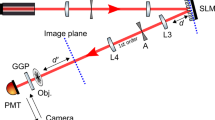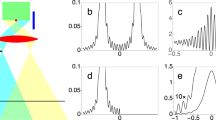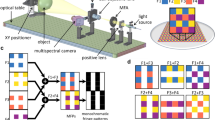Abstract
IN the light slit microscope of Schmaltz1 a narrow slit of light is projected obliquely onto an irregular surface, and the trace of the slit, viewed normally through a microscope, provides a section of the surface to a scale depending on the angle of incidence of the light. This technique has the disadvantages that (a) there is only a single slit image, which must therefore be made to traverse the surface, and (b) there is very little focal depth in the slit image if it is made narrow enough. If the width of the slit is to be d it must be projected with numerical aperture α = λ/d and the focal depth is approximately λ/α2, where λ is the wavelength of the light.
This is a preview of subscription content, access via your institution
Access options
Subscribe to this journal
Receive 51 print issues and online access
$199.00 per year
only $3.90 per issue
Buy this article
- Purchase on Springer Link
- Instant access to full article PDF
Prices may be subject to local taxes which are calculated during checkout
Similar content being viewed by others
References
Schmaltz, G., in Technische Oberflächenkcunde (Berlin, 1936).
Author information
Authors and Affiliations
Rights and permissions
About this article
Cite this article
ROWE, S., WELFORD, W. Surface Topography of Non-optical Surfaces by Projected Interference Fringes. Nature 216, 786–787 (1967). https://doi.org/10.1038/216786a0
Received:
Issue Date:
DOI: https://doi.org/10.1038/216786a0
This article is cited by
Comments
By submitting a comment you agree to abide by our Terms and Community Guidelines. If you find something abusive or that does not comply with our terms or guidelines please flag it as inappropriate.



